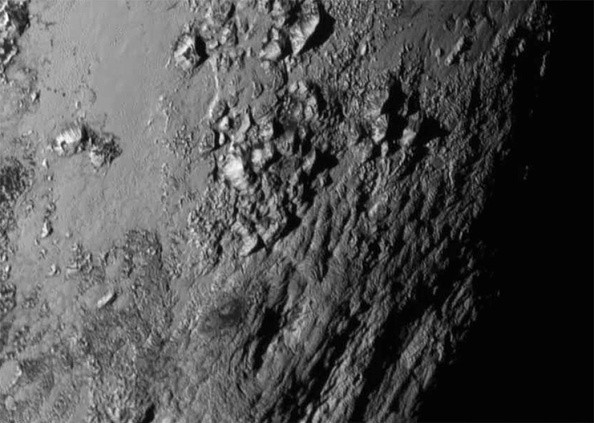Pluto's Icy Mountain Ranges Come Into View Courtesy of New Horizons
| Ana Verayo | | Jul 15, 2015 11:07 PM EDT |
(Photo : NASA/APL/SwRI via Getty Images) In this handout provided by the National Aeronautics and Space Administration (NASA), a close-up image of a region near Pluto's equator shows a range of mountains rising as high as 11,000 feet (3,500 meters) taken by NASA's New Horizons spacecraft as it passed within 7,800 feet of the dwarf planet on July 14, 2015. The 1,050-pound piano sized probe, which was launched January 19, 2006 aboard an Atlas V rocket from Cape Canaveral, Florida, zipped by the planet yesterday.
After the epic, first ever Pluto flyby conducted by NASA's New Horizons probe on Tuesday, the first set of images are now released, revealing closeup views of the complex geology of the dwarf planet.
Like Us on Facebook
During a news conference, the New Horizons team presented high resolution images of not only Pluto but also its largest moon, Charon, and also a lower resolution of Hydra, one of Pluto's tiny moons.
Upon showing these satellites, the team finally revealed unprecedented views of Pluto including its heart shaped feature which scientists have now started calling the "Tombaugh Regio" after the astronomer who discovered Pluto, Clyde Tombaugh.
Scientists have noted that the surface is not yet heavily cratered, that could suggest that it's been a relatively young surface in astronomical terms, spanning less than 100 million years. The image also reveals spectacular icy mountain ranges that reach up to 11,000 feet, according to the Los Angeles Times.
NASA explains that the presence of this mountainous landscape is also surprising since, unlike the icy moons of giant gas planets, Pluto does not possess any gravitational forces interacting with a larger planetary body. This could mean that some other process is generating this complex landscape.
Meanwhile, Charon is slowly unraveling some surprising geography, too, that includes cliffs and troughs that can hold clues to internal mineral processes that could cause widespread fractures on Charon's crust, according to NASA. There's also a canyon that is estimated to measure four to six miles deep where Pluto, on the other hand, shows a crater-less surface, reveals Newsweek.
According to New Horizons scientist Cathy Olkin, there are also various theories about the existence of the darker region located in Charon's northern pole that scientists now dub as Mordor, where the team will be looking forward to some crucial spectroscopic analysis from the probe.
What's next for New Horizons then? According to USA TODAY, the probe will hurtle toward one or two targets by the end of October that are still unnamed, also located in the Kuiper Belt, which is a region in the solar system filled with millions of icy objects, beyond the reaches of the solar system.
TagsNASA New Horizons, Pluto, icy mountains Pluto surface, images Pluto flyby surface, Charon, Pluto surface geology, what does Pluto look like, Pluto's Icy Mountain Ranges Come Into View Courtesy of New Horizons
©2015 Chinatopix All rights reserved. Do not reproduce without permission
EDITOR'S PICKS
-

Did the Trump administration just announce plans for a trade war with ‘hostile’ China and Russia?
-

US Senate passes Taiwan travel bill slammed by China
-

As Yan Sihong’s family grieves, here are other Chinese students who went missing abroad. Some have never been found
-

Beijing blasts Western critics who ‘smear China’ with the term sharp power
-

China Envoy Seeks to Defuse Tensions With U.S. as a Trade War Brews
-

Singapore's Deputy PM Provides Bitcoin Vote of Confidence Amid China's Blanket Bans
-

China warns investors over risks in overseas virtual currency trading
-

Chinese government most trustworthy: survey
-

Kashima Antlers On Course For Back-To-Back Titles
MOST POPULAR
LATEST NEWS
Zhou Yongkang: China's Former Security Chief Sentenced to Life in Prison

China's former Chief of the Ministry of Public Security, Zhou Yongkang, has been given a life sentence after he was found guilty of abusing his office, bribery and deliberately ... Full Article
TRENDING STORY

China Pork Prices Expected to Stabilize As The Supplies Recover

Elephone P9000 Smartphone is now on Sale on Amazon India

There's a Big Chance Cliffhangers Won't Still Be Resolved When Grey's Anatomy Season 13 Returns

Supreme Court Ruled on Samsung vs Apple Dispute for Patent Infringement

Microsoft Surface Pro 5 Rumors and Release Date: What is the Latest?










